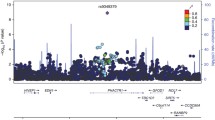Abstract.
The etiology of spontaneous cervical artery dissection (sCAD) is unknown. An underlying connective tissue disorder has been suggested. As a collagen disease is conceivable several genes encoding fibrillar collagens have been condsidered as candidate genes for sCAD. We analysed the COL3A1 gene in patients with spontaneous cervical artery dissection (sCAD) and in healthy controls, using three different genetic methods. 1) The promoter region, the 5' and 3' untranscribed regions and the N- and C- peptide encoding regions were studied by direct sequencing analysis of DNA from 12 patients. 2) A possible association of sCAD and the COL3A1 gene was tested for with 5 different DNA polymorphisms in 45 patients and 50 healthy control subjects. 3) DNA samples from a father and his two daughters, all suffering from spontaneous dissections of a cervical artery, were analysed with CA-repeat markers that flank the COL3A1 locus. No disease-causing mutations were found in an extended sequence analysis of the COL3A1 gene in patients with sCAD. However, we identified a single nucleotid polymorphism (SNP) in the promotor region in 2 patients and a 2 bp deletion in the 3' UTR in 7 patients. These sequence variants were also found among 50 healthy subjects. An analysis of multiple DNA polymorphisms of the COL3A1 locus in patients and healthy control persons did not indicate a significant association of sCAD with COL3A1. A deletion polymorphism in the 3' UTR was, however, found more often amongst patients with sCAD. The possible linkage of a hypothetical disease mutation with the COL3A1 locus was tested in a small family with three affected patients. As the affected daughters did not inherit the same COL3A1 allele from their affected father (LOD < − 2.3) COL3A1 was excluded as a disease gene in this family. This study confirms and extends earlier work which suggests that COL3A1 mutations are not a major cause for isolated sCAD.
Similar content being viewed by others
Author information
Authors and Affiliations
Additional information
Received: 26 September 2001, Received in revised form: 17 December 2001, Accepted: 9 January 2002
Rights and permissions
About this article
Cite this article
von Pein, F., Välkkilä, M., Schwarz, R. et al. Analysis of the COL3A1 gene in patients with spontaneous cervical artery dissections. J Neurol 249, 862–866 (2002). https://doi.org/10.1007/s00415-002-0745-x
Published:
Issue Date:
DOI: https://doi.org/10.1007/s00415-002-0745-x




